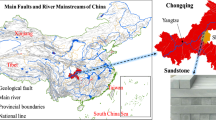Abstract
Due to the fact that the shale formations are usually featured by rich in clay mineral and well-developed bedding planes, which makes it strong water-sensitive and strength-anisotropic. Once the mass transfer of mud filtrate occurs around the borehole of the shale formation, the reaction between the shale and drilling mud causes shale to swell, weaken, and eventually fall/collapse into the wellbore. This study aimed to develop a coupled chemo-poroelastic model to accurately predict the wellbore collapse. The impacts of the chemo-poroelastic coupling, the anisotropic and weakened strength are integrated in this model. Based on the chemo-poroelastic method, the characteristics and evolution laws of failure zones around a wellbore have been simulated. The results show that the wellbore stability is time-dependent due to the influence of the chemo-poroelastic coupling and the weakened strength, the anisotropic and weakened strength have a more significant influence than the chemo-poroelastic coupling. Thus, the anisotropic and weakened strength should be involved in the analysis of wellbore stability for shale gas wells.












Similar content being viewed by others
References
Aadnøy BS, Looyeh R (2011) Petroleum rock mechanics: drilling operations and well design. Gulf Professional Publishing, Oxford
Aadnoy BS, Ong S (2003) Introduction to special issue on borehole stability. J Petrol Sci Eng 38(3):79–82
Abousleiman Y, Cui L (1998) Poroelastic solutions in transversely isotropic media for wellbore and cylinder. Int J Solids Struct 35:4905–4929
Abousleiman Y, Cui L, Ekbote S, Zaman M, Roegiers JC, Cheng AHD (1997) Applications of time-dependent pseudo-3D stress analysis in evaluating wellbore stability. Int J Rock Mech Min Sci 34(3):1.e1–1.e16
Chen M, Jin Y, Zhang G (2008) Petroleum related rock mechanics. Science Press, Beijing
Cheng YF, Wang JY, Zhao TZ, Shen HC (2006) Strength analysis of formation rock for porous media coupled with mechanical–chemical effects. Chin J Rock Mech Eng 25(9):1912–1916
Fjar E, Holt RM, Raaen AM, Risnes R (2008) Petroleum related rock mechanics, 2nd edn. Elsevier, Oxford
Ghassemi A, Diek A (2003) Linear chemo-poroelasticity for swelling shales: theory and application. J Petrol Sci Eng 38(3):199–212
Hale AH, Mody FK, Salisbury DP (1993) The influence of chemical potential on wellbore stability. SPE Drill Complet 8(3):207–216
Heidug WK, Wang SW (1996) Hydration swelling of water-absorbing rocks: a constitutive model. Int J Numer Anal Methods Geomech 20(6):403–430
Hoang SK, Abousleiman YN (2012) Correspondence principle between anisotropic poroviscoelasticity and poroelasticity using micromechanics and application to compression of orthotropic rectangular strips. J Appl Phys 112(4):044907
Huang R, Chen M, Deng J (1995) Study on shale stability of wellbore by mechanics coupling with chemistry method. Drill Fluid Complet Fluid 12(3):15–21
Labiouse V, Vietor T (2014) Laboratory and in situ simulation tests of the Excavation Damaged Zone around galleries in Opalinus Clay. Rock Mech Rock Eng 47(1):57–70
Liu M, Jin Y, Lu Y, Chen M, Wen X (2015) Oil-based critical mud weight window analyses in HTHP fractured tight formation. J Petrol Sci Eng 135:750–764
Lu YH, Chen M, Jin Y, Zhang GQ (2012) A mechanical model of borehole stability for weak plane formation under porous flow. Pet Sci Technol 30(15):1629–1638
Lu YH, Chen M, Jin Y, Ge WF, An S, Zhou Z (2013) Influence of porous flow on wellbore stability for an inclined well with weak plane formation. Pet Sci Technol 31(6):616–624
Ma TS, Chen P (2014a) Study of meso-damage characteristics of shale hydration based on CT scanning technology. Pet Explor Dev 41(2):249–256
Ma TS, Chen P (2014b) Influence of shale bedding plane on wellbore stability for horizontal wells. J Southwest Pet Univ (SciTechnol Ed) 36(5):97–104
Ma TS, Chen P (2015a) A wellbore stability analysis model with chemical–mechanical coupling for shale gas reservoirs. J Nat Gas Sci Eng 26:72–98
Ma TS, Chen P (2015b) Analysis on wellbore stability for horizontal wells in stratification shale. J Cent South Univ (Sci Technol) 46(4):1375–1383
Ma TS, Chen P, Yang CH, Zhao J (2015) Wellbore stability analysis and well path optimization based on the breakout width model and Mogi–Coulomb criterion. J Pet Sci Eng 135:678–701
Ma TS, Yang CH, Chen P, Wang XD, Guo YT (2016a) On the damage constitutive model for hydrated shale using CT scanning technology. J Nat Gas Sci Eng 28:204–214
Ma TS, Chen P, Zhang QB, Zhao J (2016b) A novel collapse pressure model with chemical–mechanical coupling in shale gas formations with multi-weakness planes. J Nat Gas Sci Eng 36:1151–1177
Mehrabian A, Abousleiman YN (2013) Generalized poroelastic wellbore problem. Int J Numer Anal Methods Geomech 37(16):2727–2754
Okland D, Cook JM (1998) Bedding-related borehole instability in high-angle wells. Paper SPE 47285 presented at the SPE/ISRM rock mechanics in petroleum engineering, Trondheim, Norway, 1998, 8–10 July
Roshan H, Rahman SS (2011) A fully coupled chemo-poroelastic analysis of pore pressure and stress distribution around a wellbore in water active rocks. Rock Mech Rock Eng 44(2):199–210
Wang Q, Zhou Y, Wang G, Jiang H, Liu Y (2012) A fluid–solid-chemistry coupling model for shale wellbore stability. Pet Explor Dev 39(4):475–480
Zeynali ME (2012) Mechanical and physico-chemical aspects of wellbore stability during drilling operations. J Pet Sci Eng 82:120–124
Zhou X, Ghassemi A (2009) Finite element analysis of coupled chemo-poro-thermo-mechanical effects around a wellbore in swelling shale. Int J Rock Mech Min Sci 46(4):769–778
Zoback MD (2007) Reservoir geomechanics. Cambridge University Press, London
Acknowledgements
This work is supported by a Grant from the China Postdoctoral Science Foundation (Grant Nos. 2017T100592 and 2016M600626); the Young Elite Scientists Sponsorship Program by CAST (2017QNRC001); and the Fund of State Key Laboratory of Oil and Gas Reservoir Geology and Exploitation of Southwest Petroleum University (Grant Nos. G201604 and PLN201611).
Author information
Authors and Affiliations
Corresponding author
Rights and permissions
About this article
Cite this article
Ma, T., Chen, Y. & Duan, M. Chemo-poroelastic Coupling Method for Wellbore Stability Analysis in Shale Gas Formation with Weakness Planes. Geotech Geol Eng 36, 1817–1831 (2018). https://doi.org/10.1007/s10706-017-0434-2
Received:
Accepted:
Published:
Issue Date:
DOI: https://doi.org/10.1007/s10706-017-0434-2




